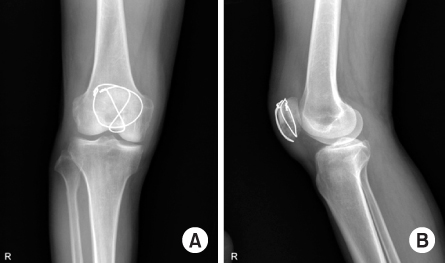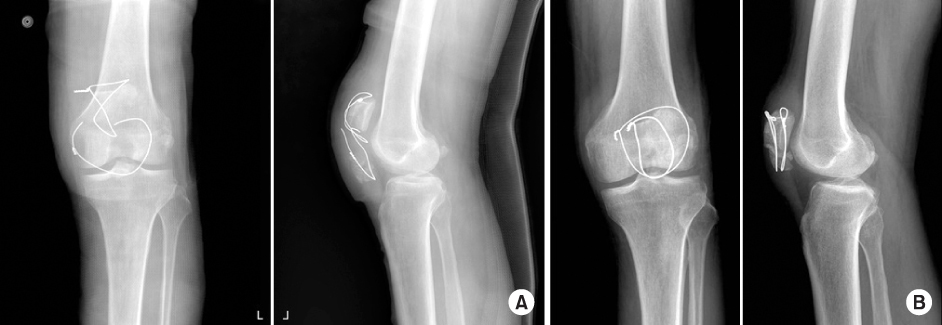J Korean Fract Soc.
2014 Jan;27(1):65-71. 10.12671/jkfs.2014.27.1.65.
Circumferential Wiring Combined with Tension Band Wiring in the Operative Treatment of Patella Fracture
- Affiliations
-
- 1Department of Orthopedic Surgery, Sahmyook Medical Center, Seoul, Korea. crash1401@naver.com
- KMID: 1817004
- DOI: http://doi.org/10.12671/jkfs.2014.27.1.65
Abstract
- PURPOSE
The purpose of this study is to evaluate the radiographic and clinical results of patella fractures using a circumferential wiring combined with tension band wiring.
MATERIALS AND METHODS
Between January 2005 and June 2012, 22 (male 14, female 8) patients with patella fracture treated with circumferential wiring combined with tension band wiring were analyzed retrospectively. The mean age of patients was 51 years (range, 28 to 72 years). Controlled passive range of motion exercise was started at three weeks from the postoperative day. The patients were evaluated using radiographs, clinical examination, and Levack's scoring system.
RESULTS
All fractures healed and mean time elapsed for union was 11.5 weeks (range, 10 to 14 weeks). Complete union without displacement and full range of motion was achieved in all cases. Clinical results according to Levack's scoring system were excellent in 20 cases and good in two cases. We found broken wire in one case. In this case, results of clinical evaluation after reoperation were good.
CONCLUSION
Circumferential wiring combined with tension band wiring is appropriate for patella fractures.
Keyword
Figure
Reference
-
1. Benjamin J, Bried J, Dohm M, McMurtry M. Biomechanical evaluation of various forms of fixation of transverse patellar fractures. J Orthop Trauma. 1987; 1:219–222.
Article2. Berg EE. Open reduction internal fixation of displaced transverse patella fractures with figure-eight wiring through parallel cannulated compression screws. J Orthop Trauma. 1997; 11:573–576.
Article3. Boström A. Fracture of the patella. A study of 422 patellar fractures. Acta Orthop Scand Suppl. 1972; 143:1–80.
Article4. Böstman O, Kiviluoto O, Nirhamo J. Comminuted displaced fractures of the patella. Injury. 1981; 13:196–202.
Article5. Carpenter JE, Kasman R, Matthews LS. Fractures of the patella. J Bone Joint Surg Am. 1993; 75:1550–1561.
Article6. Carpenter JE, Kasman R, Matthews LS. Fractures of the patella. Instr Course Lect. 1994; 43:97–108.
Article7. Curtis MJ. Internal fixation for fractures of the patella. A comparison of two methods. J Bone Joint Surg Br. 1990; 72:280–282.
Article8. Hung LK, Chan KM, Chow YN, Leung PC. Fractured patella: operative treatment using the tension band principle. Injury. 1985; 16:343–347.
Article9. Leung PC, Mak KH, Lee SY. Percutaneous tension band wiring: a new method of internal fixation for mildly displaced patella fracture. J Trauma. 1983; 23:62–64.10. Levack B, Flannagan JP, Hobbs S. Results of surgical treatment of patellar fractures. J Bone Joint Surg Br. 1985; 67:416–419.
Article11. Lotke PA, Ecker ML. Transverse fractures of the patella. Clin Orthop Relat Res. 1981; (158):180–184.
Article12. Ma YZ, Zhang YF, Qu KF, Yeh YC. Treatment of fractures of the patella with percutaneous suture. Clin Orthop Relat Res. 1984; (191):235–241.
Article13. McMaster PE. Fractures of the patella. Clin Orthop. 1954; 4:24–43.14. Park SW, Woo KJ, Byun YS. Clinical Study of Patellar Fracture. J Korean Soc Fract. 1991; 4:112–118.
Article15. Scapinelli R. Blood supply of the human patella. Its relation to ischaemic necrosis after fracture. J Bone Joint Surg Br. 1967; 49:563–570.16. Scott JC. Fractures of the patella. J Bone Joint Surg Br. 1949; 31B:76–81.
Article17. Smith ST, Cramer KE, Karges DE, Watson JT, Moed BR. Early complications in the operative treatment of patella fractures. J Orthop Trauma. 1997; 11:183–187.
Article18. Son MH, Kim BC, Kang NW, Choi TY. Treatment of patellar fractures with modified tension band wiring. J Korean Soc Fract. 1999; 12:872–878.
Article19. Suh JT, Yun PJ, Yoo CI. Arthroscopy-guided fixation of patella fractures. J Korean Knee Soc. 1997; 9:103–107.20. Tandogan RN, Demirors H, Tuncay CI, Cesur N, Hersekli M. Arthroscopic-assisted percutaneous screw fixation of select patellar fractures. Arthroscopy. 2002; 18:156–162.
Article21. Turgut A, Günal I, Acar S, Seber S, Göktürk E. Arthroscopic-assisted percutaneous stabilization of patellar fractures. Clin Orthop Relat Res. 2001; (389):57–61.
Article22. Weber MJ, Janecki CJ, McLeod P, Nelson CL, Thompson JA. Efficacy of various forms of fixation of transverse fractures of the patella. J Bone Joint Surg Am. 1980; 62:215–220.
Article
- Full Text Links
- Actions
-
Cited
- CITED
-
- Close
- Share
- Similar articles
-
- Operative Treatment of patellar Fractures
- Modified tension band wiring and Circumferential wiring in the operative treatment of patella fracture
- Treatment of Patella Fracture Using Wiring Method
- Results of Surgical Treatment of Patellar Fractures: With Tension Test for the Rigidity of Fixation Methods
- Tension band wiring and Modified tension band wiring in the Operative Treatment of Patella Fracture




